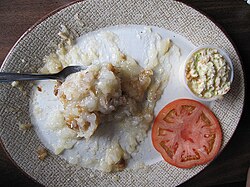Rappie pie
 A serving of Rappie pie, on a plate with tomato and dressing | |
| Alternative names | Rapure pie, râpure |
|---|---|
| Place of origin | Canada |
| Region or state | Nova Scotia, Prince Edward Island |
| Main ingredients | Potatoes, broth (chicken, pork or seafood), meat, onions |
| Part of a series on |
| Canadian cuisine |
|---|
|
|
Rappie pie is a traditional Acadian dish from southwest Nova Scotia[1] and areas of Prince Edward Island. It is sometimes referred to as "rapure pie" or "râpure".[2][3] Its name is derived from the French "patates râpées" meaning "grated potatoes".[4] It is a casserole-like dish traditionally formed by grating potatoes, then squeezing them through cheesecloth. This removes some of the water from the potato solids. The liquid removed is replaced by adding hot broth made from chicken, pork or seafood along with meat and onions, and layering additional grated potatoes over the top.[5][6] Common meat fillings include beef, chicken, or bar clams.
History
It is thought that rappie pie has its origins in the Acadian Expulsion, among Acadians who lived out their exile in Massachusetts. This opportunity to meet and interact with other immigrant groups would naturally encourage a sharing of cultural recipes. It may have been German or Swiss immigrants who taught the Acadians their technique for using grated potatoes in their recipes, but whoever it was, this proved to be an important tip for those that returned to Nova Scotia when the expulsion was lifted. When they returned, they found that their fertile land had been given to New Englanders lured north by the promise of farmland. The harsh, rocky land that remained was excellent for growing potatoes, if little else, so the Acadians used them to fill out dishes made with what game was available.[4][7]
See also
- Gratin, the French cuisine cooking technique
- Rösti, the national Swiss dish of shredded potatoes
- Hotdish, the Northern Midwestern American casserole
- List of casserole dishes
References
- ^ "Traditional Acadian foods make warmly satisfying meals". saltscapes.com. Saltscapes. Retrieved November 1, 2017.
- ^ Kittler, Pamela Goyan; Sucher, Kathryn (2007-06-27). Food and culture. Cengage Learning. p. 519. ISBN 978-0-495-11541-0. Retrieved 9 March 2011.
- ^ Karr, Paul (2010-05-03). Frommer's Nova Scotia, New Brunswick & Prince Edward Island. Frommer's. p. 82. ISBN 978-0-470-58250-3. Retrieved 9 March 2011.
- ^ a b Dornbusch, Jane (April 21, 2015). "Humble Nova Scotia rappie pie used to include scraped knuckles". bostonglobe.com. Boston Globe. Retrieved November 1, 2017.
- ^ Laugher, Nick (December 3, 2014). "Rappie Pie Is a Gooey, Fatty Touchstone of Acadian Culture". munchies.vice.com. VICE. Retrieved November 1, 2017.
- ^ Meyer, Bernard (1988-01-01). Bernard Meyer's East Coast Cuisine: Regional Cooking With French Flair. Formac Publishing Company. p. 100. ISBN 978-0-88780-063-4. Retrieved 9 March 2011.
- ^ Roy, Suman and Brooke Ali (2010). From Pemmican to Poutine: A Journey Through Canada's Culinary History. Toronto: The Key Publishing House, Inc. p. 14. ISBN 978-1-926780-00-9.
